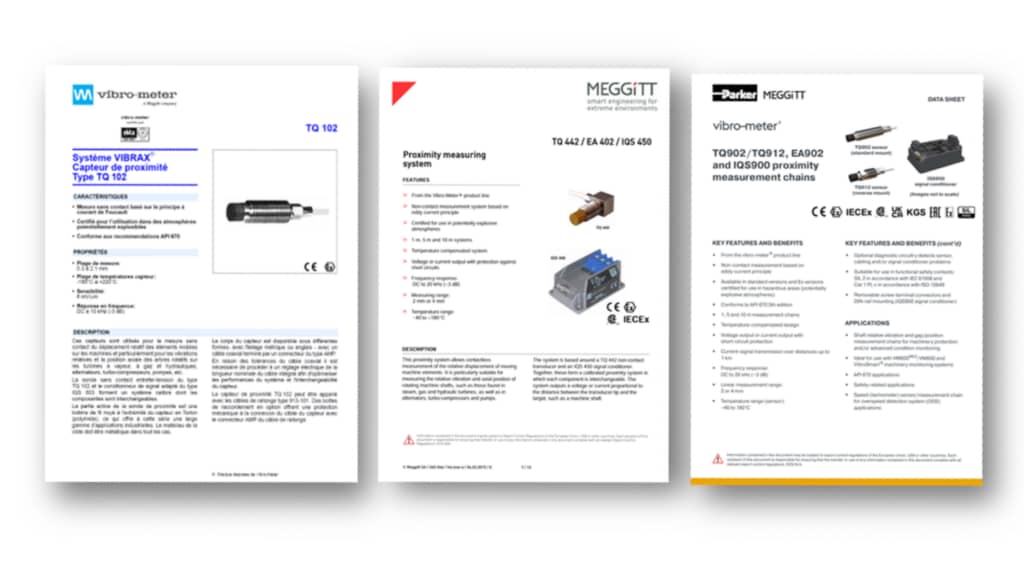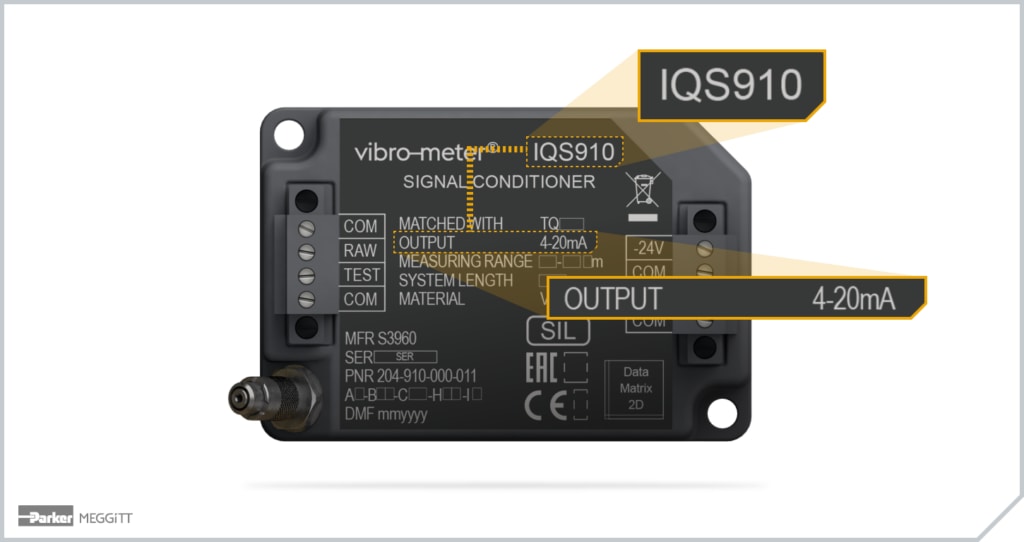
With the founding of vibro-meter in the 1950s, we quickly established ourselves for not just innovation, but, as a Swiss company, for a level of quality that is consistent with the proverbial “Swiss watch”. Our earliest years focused primarily on accelerometers and piezo-electric devices, but we understood then – as we do now – that customers require a comprehensive suite of transducers for their machinery monitoring needs, encompassing both casing measurements and shaft-relative measurements. For this reason, we have been manufacturing eddy-current displacement sensors for most of our history and have delivered more than 100,000 TQ-series proximity sensing systems during that time, beginning with our TQ1XX series, then our TQ4XX series, and today our TQ9XX series.
In this article, we’d like to discuss a specific part of the proximity system: the signal conditioner, represented by our IQS9XX1 series of products.
The driving forces in proximity sensing systems are accuracy and robustness. Let’s talk first about robustness.

Unlike many other types of sensors, proximity sensors are frequently embedded deep in the machine, under bearing caps, and generally inaccessible. If a probe fails, a replacement may not be feasible until a scheduled outage – months or years away. In the meantime, a customer must simply limp along without a vital measurement. This can be compounded when a single sensor provides data used by many other sensors, as is the case for a phase reference (or so-called “tacho”) probe. But it can also be important to dual-voting thrust position measurements, differential expansion measurements, and radial vibration measurements relying on Smax where two probes are required. Expecting customers to install spare probes in the event one fails is impractical in many cases due to limited room inside the bearing, and it also becomes prohibitively expensive. While sometimes done for phase reference signals, and occasionally for thrust where a 2-out-of-3 voting arrangement is used, installed spare “back up” probes are both impractical and expensive.

A better solution is simply probe systems that are engineered to serve reliably for 15 years or more, without failure, and with robustness that recognizes the realities of an industrial plant, aggressive environments, and personnel that may not always be as gentle with instrumentation and sensors as we’d hope.

Accuracy is also important for many of the same reasons. Simply removing a probe from service to check its calibration or adjust it in some fashion is not an option for the same reasons previously listed: probes are often inaccessible without an outage. But there is another important consideration at work, too. That consideration is interchangeability and the fact that a proximity measurement chain consists of not just a single sensor, but also a matched length of coaxial cable and a tuned signal conditioner. Replacing a cable and a signal conditioner just because a sensor fails, or a sensor just because a signal conditioner fails, is untenable for most users. For this reason, very tight interchangeability tolerances exist in industry standards such as API 6702 that dictate the ability to exchange only a probe, or only a cable, or only a signal conditioner, and still have the sensing chain perform within a narrow margin of performance deviation – a mere ± 5% for ISF3 and ± 25.4 μm for DSL3 within the Testing Range. This requires very rigorous quality control so that a probe manufactured 5 years ago will work with a cable manufactured 4 years ago and a signal conditioner manufactured last month, all perhaps supplied by different entities: the OEM that supplied probes with their machine, a system integrator that installed the extension cable at site, and the end user that purchased a spare signal conditioner just last month after a lightning strike damaged the original. This is the real world in which our products must perform and this is the real world in which performance specifications must be maintained.
Some manufacturers have attempted to circumvent this by making “universal” programable signal conditioners that can simply be matched in the field to a specific probe and cable by adjusting the calibration curve via software. While this is a nice idea in theory, in practice it means that each probe, cable, and signal conditioner with different serial numbers must be “matched” and without this matching, will not come very close to meeting the specifications of API 670. This gives rise to the unfortunate situation that if a cable needs to be replaced, from a practical perspective the customer must either replace all three elements in the sensing chain, or must remove all the elements from service, introduce the new component (such as replacing a damaged probe), and then running a calibration curve against the new system consisting of all three components. A more user-centric approach in most cases is simply to manufacture probes, cables, and signal conditioners with sufficient quality control rigor that they can be interchanged without the need for recalibration, yet still perform within the constraints of API 670 to ensure highly accurate readings that can be relied upon for machinery protection and for condition monitoring.

We earlier mentioned our TQ1XX proximity systems, followed by our TQ4XX series, and eventually the TQ9XX series offered today. These products have spanned more than four decades and while we have introduced innovation at every step of the way (and which we will talk about a little later in this article), we do not ask customers to switch to new systems every few years: it’s simply too disruptive and generally unnecessary. Changing out an embedded proximity sensor is not like simply upgrading a piece of software – or even firmware.
In a world where new versions of consumer products – like TVs and mobile devices – are being introduced every year, you may wonder why versions of a product like proximity systems move so much slower. In a nutshell, it’s all about backwards compatibility and the impositions of asking customers to change out something as critical as a measurement chain. When a proximity sensor (or any sensor we make, for that matter) goes into service, customers generally expect it to provide reliable service for 15, 20, or even 25 years. In contrast, we are now almost at the place with consumer electronics where they become obsolete after a couple of years, and the build quality is often so poor that we are offered “extended warranties” after the original one- or two-year manufacturer’s warranty expires. This approach simply isn’t acceptable for industrial products.
For OEMs that buy our products and embed them into their machines, it also means a major imposition in terms of testing and approving the new devices, changing all of their documentation and purchasing documents, and generally transitioning their organization over to the new product. There are costs associated with this and these need to be considered instead of breathlessly announcing new versions every few years.
Thus, industrial products do not follow this same pattern not because they could not, but because customers do not want them to. It represents too much “churn” and too much expense. They expect products with lifespans and MTBFs4 measured in decades. They also expect that – to the extent practical – new products are backwards compatible with older products – such as signal conditioners that are backwards compatible with older probes and cables. A probe system really has just one job: deliver accurate, linear, repeatable measurements that are stable over a reasonable range of storage and operating temperatures. If a product can do that for several decades, there is no compelling reason to force customers to upgrade, even if improvements can be introduced more rapidly.
Ironically, the thing that often causes us to obsolete a sensing system is that the components used to manufacture it become obsolete from our suppliers. Because we can no longer get the components, we can no longer build the finished products. That was the situation, for example, back in 2004 when we were forced to obsolete the TQ1XX series and companion IQS603. This was replaced by our TQ4XX series proximity sensors and IQS450 signal conditioner.

More recently, we introduced our TQ9XX series proximity sensors and IQS9XX signal conditioner. These products represent important improvements over prior generations of proximity sensing chains, but this must always be balanced against delivering sensing products with useful lives that are at least 15 years in most cases.
We introduced the IQS900 signal conditioner in 2022, complementing our line of TQ9XX proximity sensors and EA9XX extension cables introduced in 2020.
To see the numerous improvements, hover over the hotspots in the images below.
[vision id="3"]
[vision id="5"]
One of the primary goals in the new 9XX series was not only to deliver more robust probes and cables, but to deliver backwards compatibility of the new signal conditioners with TQ4XX probes and cables. This allows an IQS9XX to be used with existing TQ4XX probes and EA4XX cables – as well as with TQ9XX probes and EA9XX cables. This means all of the benefits of an improved signal conditioner can be delivered to the large installed base of TQ4XX-series probes and cables.
We recognize that not every machine warrants a conventional, stand-alone monitoring system and there are instances where a machine requiring proximity sensors can be adequately protected by means of a 4-20mA signal into a control system such as a PLC or DCS. In these instances, our IQS910 delivers all of the benefits and functionality of the IQS900, but provides the signal in a proportional 4-20mA format that can be connected directly to an analog input module on a PLC, DCS, SCADA, or special-purpose machine control platform. The result is a high-quality measurement but without the accompanying costs of a dedicated vibration monitoring system.

Like the IQS900, the IQS910 is available with optional diagnostics and a corresponding SIL 2-rating. This makes it a good fit for loops within a Safety Instrumented Function (SIF) application where other SIL-rated inputs might also be present such as temperature, flow, level, pressure, and other process variable signals.
Also, like the IQS900, both RAW and TEST connections are available for ease of commissioning, verifying, and troubleshooting the device without the need to remove output wiring or for the probe tip to observe a micrometer or shaker table target. The manual goes into more detail on the TEST and RAW connections, but suffice to say that they permit a simulated signal to be input to the device and generate a known output.
With backwards compatibility to our complete line of TQ4XX and TQ9XX probes and cables, all the benefits of the IQS900 and IQS910 extend across our entire5 proximity sensing portfolio. You can learn more about these two signal conditioners, eddy-current proximity offerings, and our entire portfolio of sensing chains, monitoring systems, and services by contacting your local vibro-meter professional.
[1] This includes both the IQS900 with its dynamic voltage or current output, and the IQS910 loop-powered proximity vibration/position “transmitter” with its 4-20mA quasi-static output.
[2] Refer to American Petroleum Institute Standard 670, 5th edition, §4.6.
[3] ISF = Incremental Scale Factor; DSL = Deviation from Straight Line.
[4] Mean Time Between Failures
[5] Excluding our WW018 and RE022/030 proximity offerings.